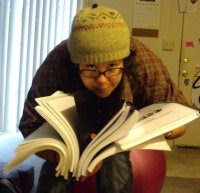In my efforts to get some more work done on my thesis I've been concentrating my efforts on The Fruit of the Tree. I got myself onto the Wharton-l and started asking around to see what opinions other Wharton reserchers and readers might have. I have gotten back some interesting leads, one suggesting an edition of the novel edited by Donna Campell, and another directing me to a lecture given at the Mount last year by Dr. Jennie Kassanoff. I've emailed Dr. Kassanoff since I've been unable to find a copy of her lecture, and I'm on the look out for the Campbell edition in the University library.
My theory at the moment is that the novel may well have been based on the Hoosic River Valley. I have a few reasons for this.
1. The novel is set in the Moosuc River Valley (old spelling of Hoosic is Hoosuc. Similarity?)
2. The city of Adams is along the Hoosic and was the site of a large cotton mill 3. Adams mills were in the news quite a bit during 1906 due to worker strikes
4. Wharton was living in Lenox about 20 miles south of Adams
Even if there is no way to prove that Hanaford is based on Adams I think that I could make a strong case that the descriptions of fictional Hanaford strongly resemble the ecological and social concerns in Adams during the time in which the novel was written.
My next challenge is finding sufficient environmental history regarding this region. I am particularly interested in how the river was engineered and otherwise degraded to benefit the mill in the time leading up to the 1907 publication date of Wharton's text. I am also very interested in any wetland drainage that may have occured in the area. Some contemporary sources indicate that there are few wetlands in the Hoosic Watershed but several older maps (1930's) show a number of small ponds in the area. This part of the search for information has been slow going so far. I think I might need to get in touch with some history folk for better leads.
My interest in this wetlands aspect is due to the quote at the end of the novel:
"And do you remember how we said that it was with most of us as it was
with Faust? That the moment one wanted to hold fast to was not, in most
lives, the moment of keenest personal happiness, but the other kind--the
kind that would have seemed grey and colourless at first: the moment
when the meaning of life began to come out from the mists--when one
could look out at last over the marsh one had drained?"
A tremor ran through Justine. "It was you who said that," she said,
half-smiling.
"But didn't you feel it with me? Don't you now?"
"Yes--I do now," she murmured.
He came close to her, and taking her hands in his, kissed them one after
the other.
"Dear," he said, "let us go out and look at the marsh we have drained."


3 comments:
I believe the river is the Housatonic, which run from northern Berkshire county down to and through CT. When i was at the mount this summer, the tour guide told me that the mills that inspired Edith were in Adams and North Adams some of which are still standing. infact Mass. MOCA is housed in one of them. If I can help in any way let me know!
Love Ya A
Hathaway shirts were made in the mill in adams Hanaford=Hathaway?
just checking out the map on co2 all i can say is holy crap why so much out this way?
Post a Comment